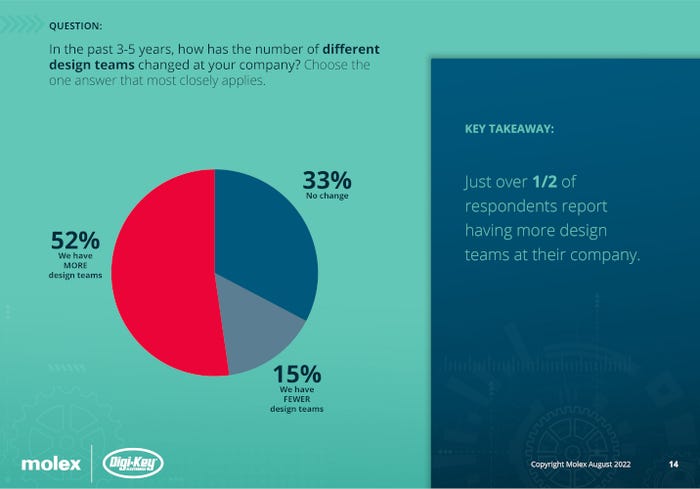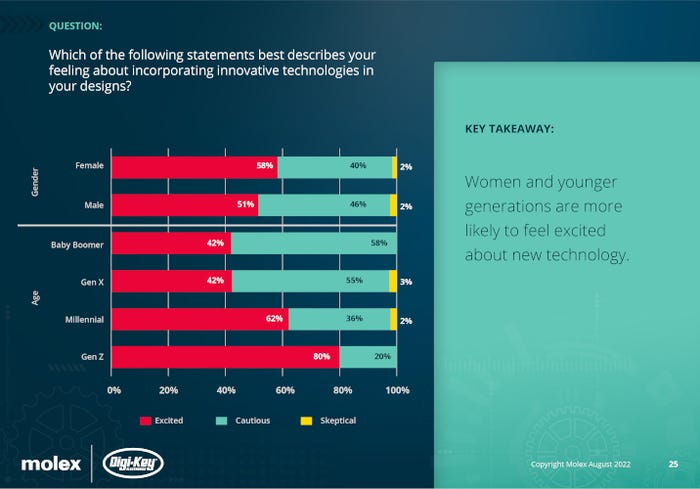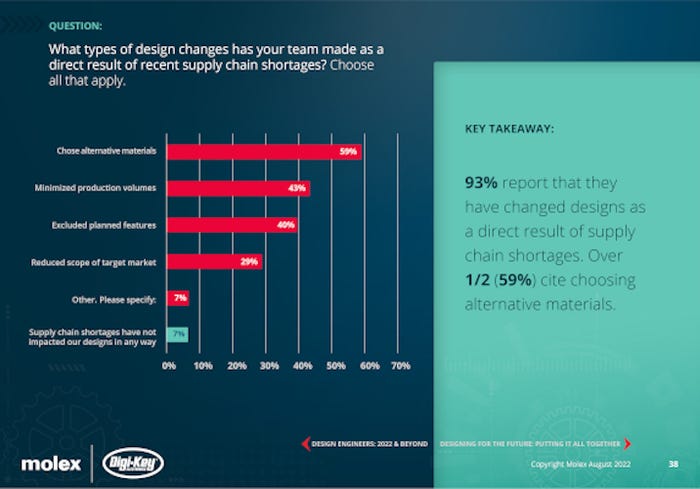Best Practices for Reducing Design Complexity in Disruptive Times
Engineers must embrace new tools and develop new skills to manage these design challenges.

Today, more than ever, design engineers are empowered to take greater control over their work, especially as they strive to meet heightened customer expectations and a relentless drive for innovation. For many, shrinking product design cycles, coupled with persistent supply-chain constraints, are adding layers of complexity while disrupting product development methodologies and timelines.
At the heart of these challenges is the overarching goal to make products smaller and denser and drive higher bandwidth while meeting demands for increased functionality, reliability, and energy efficiency. Mounting pressure to be more agile is being felt across the entire design landscape, as reflected in an industry survey commissioned by Molex and Digi-Key Electronics.
According to “Design Engineer Tell-All: Advancing Innovation in an Era of Disruption,” 58% of those polled report that design cycles are getting faster while 98% identified various factors that complicate their efforts, including supply-chain issues, high customer expectations, and design complexity. More than 500 respondents from the United States, Canada, China, Germany, Japan, and the United Kingdom weighed in on several key issues, reporting that design cycles are accelerating up to 40% over previous years.
To accommodate growing requirements, more than half of those polled said they increased the size (57%) and number (52%) of their design teams over the past five years. The addition of improved design tools and technologies also are making big impacts in helping designers simplify increasingly complex design processes while boosting productivity.

A ‘Three-T’ Approach to Design
The most practical and pragmatic methodology for taking on tough challenges requires investment in a “three-T” approach: tools, teams, and talent. For instance, data-driven tools for performing predictive analytics are being deployed much earlier in the development phase to speed iterative design steps while mitigating risk. Software-based simulations also are taking place at the mechanical level to ensure different design geometries meet increasingly tighter tolerance specifications in order to meet electrical expectations. The opportunity to analyze performance under different environmental conditions is the most expedient way to find and alleviate potential points of failure.
In the world of high-speed connectivity, the ongoing quest to break performance barriers has led to the doubling of transmission speeds over the past six to eight years. New and inventive ideas also are needed to improve both density and bandwidth of high-speed connectivity solutions while ensuring low latency and high durability. As a result, design engineers must continuously reinvent processes to take advantage of capabilities that previously were not possible. Additionally, engineers are confronted with different, and sometimes unforeseen, variables that get introduced at faster speeds. This requires new levels of talent and teamwork to develop and execute a vision that only comes into clear focus after iterative design cycles and rigorous quality testing.
Luckily, the days of designers working solo or in silos have given way to collaborative global teams with the ability to transcend geographical boundaries. If the pandemic has shown the global workforce anything, it is that working remotely or alone should be no impediment to working together. Increased adoption of innovative digital technologies, including augmented reality (AR), virtual reality (VR), and digital twins, close geographical gaps while facilitating cross-functional team cooperation.
Engaging together and participating in collective design reviews bring together all the views and voices for the best in diversity of thought, experience, and knowledge. Simply creating larger teams, however, is not the end-all answer. In fact, engineers who participated in the Molex survey reported that typical design engineers need to improve their skills in the following areas: supply-chain management, people and team skills, digital technologies, new design tools, and artificial intelligence (AI) or machine learning as well as user experience and form factors.
Across the board, design engineering teams are facing a need for new areas of expertise and knowledge. In the datacom space, for example, a long list of specialized skills is required, encompassing signal integrity, termination technology, heat dissipation, materials science, miniaturization, power management, and more.
From time to time, the development of a “SWAT-like” team of experts functioning as a think tank is a highly effective and expedient solution for tackling these varied and highly specialized design criteria. In developing Molex’s Mirror Mezz Pro connector, for instance, a separate team of engineers well versed in miniaturization collaborated on board-to-board connector designs ideally suited for extremely tight spaces. The goal was to make a connector small enough to leave room for other key components on a board without sacrificing performance. The special engineering team created a novel, self-mating interface available in various heights to handle data-intensive applications in the smallest form factor possible.
To achieve the highest levels of performance and productivity, it is important to foster teamwork among groups featuring both engineering veterans and newcomers as one can learn from the other. While senior team members typically bring decades of hands-on experience and field-proven expertise, younger team members usually are more adept at the latest and greatest digital technologies and software tools. Together, highly experienced and novice design engineers can form a formidable force for taking on today’s toughest design challenges.

Explore, Experiment, and Test
With increased teamwork comes greater adoption of agile development methodologies or continuous improvement/continuous delivery (CI/CD) to aid and speed design initiatives. At the same time, a growing number of testing labs, makerspaces, and innovation centers serve as highly effective incubators for experimentation while providing design teams with access to the latest digital tools and technologies. Not only are these facilities great breeding grounds for innovation, but they are also well suited for optimizing final product designs.
Labs focused on raw material validation, for example, can help designers confirm that their selection will meet desired performance criteria right from the concept level. Being able to prove a material’s physical or electrical characteristics as the design process advances ensures the correct building blocks are in place. Environments dedicated to testing also are crucial for confirming that product designs can scale to volume manufacturing without deviations in performance or quality.
As product designs evolve, quality engineers take on the crucial role of ensuring mechanical and electrical designs can deliver the desired performance. This task becomes even more difficult when creating component and part designs for silicon that has yet to be developed. It is critical for everyone to fully understand that achieving the ideal balance of functionality and quality typically necessitates multiple rounds of revisions and refinements.
For example, the development of Molex’s NearStack direct-to-chip solution necessitated specialized knowledge, extensive thermal research, and advanced manufacturing to create a connector that could be placed directly on the chip substrate. Not only did this require an overall strategy for addressing both substrates and PCB connectivity within a chassis or between multiple chassis, but it also demanded precision mechanics and automated assembly on the manufacturing line. A vast assortment of issues had to be evaluated carefully and validated completely before moving forward.
Of course, it takes well-coordinated teamwork to negotiate and navigate trade-offs while avoiding excessive costs and time delays. To that end, global design teams capable of working in a “follow the sun” approach keep projects on time and on budget by passing work between team members spread across different countries and time zones.
Embrace Proof-of-Concept Designs to Reduce Risk
According to 85% of the participants in the Molex survey, engineers feel responsible for final designs after they have been approved, which is why there is a concerted effort to better understand supply-chain risks. Having greater flexibility and control over vendor selection also is important as it enables designers to make bigger contributions across all aspects of the product management lifecycle.
Keeping a watchful eye on the availability of critical materials, such as certain resins and metals, is key.
Equally important is ensuring that alternate materials have been qualified and appropriated, even if this requires stepping outside the comfortable realm of frequently used suppliers. According to the survey, 59% of respondents revealed they had to choose alternate materials given lingering supply-chain shortages. In other cases, survey participants were forced to minimize production volumes or exclude planned features as a result of continued market disruption.

Every different product design phase has its own complexities and considerations, which is why engineers increasingly are starting with a proof-of-concept that allows for careful evaluation before moving to the next design phase. Investing in this first can save weeks to months in the overall timeline while offering numerous opportunities to troubleshoot performance before moving onto expensive tooling and other production aids. Another market accelerant lies in overall manufacturing processes as most complex product designs require high levels of manufacturing automation and precision.
Increased adoption of AI modeling, simulations, and 3D printing are highly effective at streamlining complicated product designs. Let’s face it—product designs are only going to get more complicated, which is why engineers who embrace best practices, new tools, and diverse teams will be best positioned to influence their design destinies and leapfrog the competition.
About the Author(s)
You May Also Like





